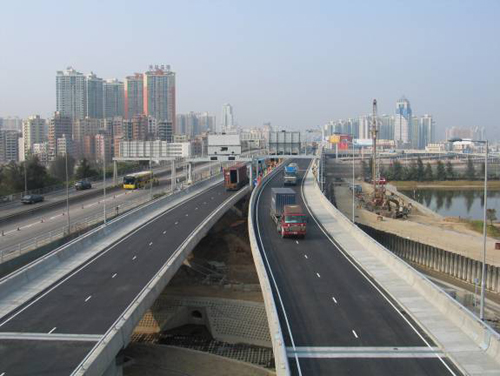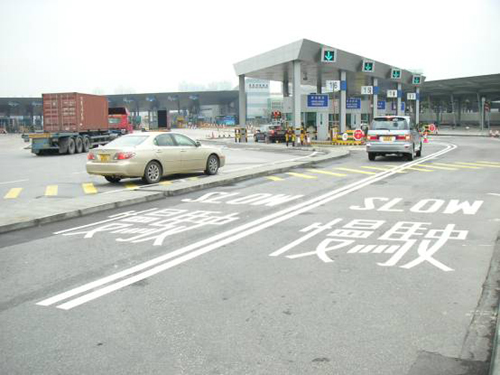
The Governments of the Hong Kong Special Administrative Region (HKSAR) and the Mainland have been making concerted efforts to improve cross-boundary transport infrastructure in order to support the ever increasing economic cooperation between the two places, and the resultant increase cross-boundary passenger and freight traffic demand. The sustained cooperation between the two Governments has greatly enhanced the socio-economic development of the Pearl River Delta Region.
At present, there are four land crossings between Hong Kong and the Mainland, i.e. Lok Ma Chau, Man Kam To, Sha Tau Kok and Shenzhen Bay. Their average daily traffic volume is about 44 000 vehicle trips.
With a daily flow of around 32 000 vehicles, Lok Ma Chau is the busiest control point in terms of cross-boundary vehicular traffic volume. Expansion works at the control point were completed in September 2003. The immigration hall was expanded and renovated, and the number of clearance counters increased, significantly enhancing the passenger handling capacity of the control point. Subsequently, the HKSAR and Shenzhen Municipal Governments embarked on a joint project to construct a new boundary bridge between Lok Ma Chau and Huanggang. The new bridge was commissioned in January 2005. The total capacity of the boundary bridges between Lok Ma Chau and Huanggang has since doubled and the traffic flow has been improved. The designation of the new and old bridges to the exclusive use by freight and passenger traffic respectively has also resulted in improvement in traffic management.

Cross-boundary traffic has seen significant improvement after the commissioning of the new boundary bridge between Lok Ma Chau and Huanggang jointly built by the Hong Kong and Shenzhen Governments.
Four additional private car kiosks were provided in each of the northbound and southbound directions at the Lok Ma Chau Control Point in October 2004 and early September 2005 respectively. Our objective is to increase the vehicle handling capacity at the control point, as well as to cater for the ever-growing traffic between Guangdong and Hong Kong.

Vehicle handling capacity of the Lok Ma Chau Control Point has increased with the addition of four private car kiosks in each of the southbound and northbound directions.
The Sha Tau Kok Control Point also witnessed the completion of a new boundary bridge, again a joint project by the HKSAR and Shenzhen Municipal Governments. Commissioned in January 2005, the bridge has increased the total capacity of the boundary bridges at Sha Tau Kok Control Point, and helped improve the traffic flow by allowing the designation of the old and new bridges to the exclusive use of southbound and northbound vehicles respectively.
At present, Lo Wu is the most popular cross-boundary crossing among passenger travellers. The average daily number of passengers it handles is 250 000, but the figure reaches over 390 000 on festive days. To improve the control point facilities, the HKSAR Government has carried out various improvement works at the Lo Wu Control Point, including the expansion of the departure hall, the widening of passageway etc, which have significantly enhanced the efficiency of the control point and provided a better environment for travellers.
In order to meet the demand for cross-boundary traffic being generated by the closer economic integration and more intensive interactions among different arenas in Hong Kong and the Mainland, the Governments of the HKSAR and Guangdong review from time to time the number of quotas for cross-boundary vehicles, having regard to the handling capacity of the control points. In August 2004, the relevant authorities of the HKSAR and Guangdong Provincial Governments enhanced the regulation of cross-boundary coach services and approved six short-haul cross-boundary coach services running between the Huanggang Control Point in Shenzhen and various districts in Hong Kong. To tie in with the commissioning of the Shenzhen Bay Port, the two Governments have issued 300 quotas for the operators to provide cross-boundary coach services via the new crossing.
There is a well-established communication mechanism between Hong Kong and the Mainland on cross-boundary traffic at the Lo Wu Control Point. Before periods when high cross-boundary traffic volume is expected, the relevant authorities of the Governments of the HKSAR and the Mainland meet to prepare passenger traffic forecast and agree on contingency measures for traffic facilitation, such as triggering contra-flow operation and adjusting the train service at Lo Wu as appropriate.
Since the introduction of two additional pairs of Guangzhou-Hong Kong Through Trains (GZTT) on 18 April 2004, the frequency of GZTT service has been increased from ten to twelve pairs a day. Taking into account the Through Trains to Beijing and Shanghai, there are altogether 26 Through Trains running between Hong Kong and the Mainland daily. According to the latest timetable, the last northbound train departs from Hung Hom at 1915 hours (arrives at Guangzhou at 2100 hours) and the last southbound train departs from Guangzhou at 2123 hours (arrives at Hung Hom at 2300 hours).
 |
Shenzhen Bay Bridge |
 |
Sheung Shui to Lok Ma Chau Spur Line |
 |
Hong Kong – Zhuhai – Macao Bridge |
 |
Guangzhou-Shenzhen-Hong Kong Express Rail Link |